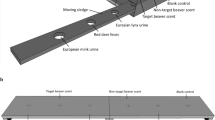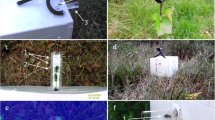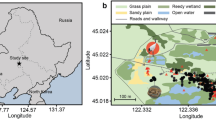Abstract
IN northern Europe, broad four-year oscillations in small rodent and raptor populations are synchronous over hundreds of square kilometers1–6. Crashes in vole populations can induce wide emigration (> 1,000 km) of their predators7 –9, but almost nothing is known about how predators rapidly detect areas of vole abundance. Here we report on laboratory and field experiments on voles (Microtus agrestis) and kestrels (Falco tinnunculus). Voles mark their runaways with urine and faeces, which are visible in ultraviolet light. Wild kestrels brought into captivity were able to detect vole scent marks in ultraviolet light but not in visible light. In the field, kestrels hunted preferentially near experimental nest-boxes where artificial trails were treated with vole urine and faeces. We suggest that kestrels flying over an area can see and use vole scent marks to assess vole numbers. This ability would enable kestrels to 'screen' large areas in a relatively short time. Our results provide a novel explanation for how raptors detect patches of high vole densities without prior knowledge of local food resources.
This is a preview of subscription content, access via your institution
Access options
Subscribe to this journal
Receive 51 print issues and online access
$199.00 per year
only $3.90 per issue
Buy this article
- Purchase on Springer Link
- Instant access to full article PDF
Prices may be subject to local taxes which are calculated during checkout
Similar content being viewed by others
References
Finerty, J. P. The Population Ecology of Cycles in Small Mammals. Mathematical Theory and Biological Fact (Yale University Press, New Haven and London, 1980).
Kalela, O. Ann. Acad. Sci. Fenn. A IV 66, 1–38 (1962).
Hanski, I. et al. Nature 364, 232–235 (1993).
Korpimäki, E. Oikos 45, 281–284 (1985).
Korpimäki, E. & Norrdahl, K. Ecology 72, 814–826 (1991).
Korpimäki, E. J. Anim. Ecol. 63, 619–628 (1994).
Andersson, M. J. Anim. Ecol. 49, 175–184 (1980).
Ward, R. M. P. & Krebs, C. J. Can. J. Zool. 63, 2817–2824 (1986).
Korpimäki, E., Lagerström, M. & Saurola, P. Ornis Scand. 18, 1–4 (1987).
Village, A. The Kestrel (Poyser, London, 1990).
Johnson, R. P. Behaviour 55, 81–93 (1975).
Rozenfeld, F. M., Le Boulange, E. & Rasmont, R. Can. J. Zool. 65, 2594–2601 (1987).
Desjardins, D., Maruniak, J. A. & Bronson, F. H. Science 182, 939–941 (1973).
Norrdahl, K. & Korpimäki, E. Oikos 67, 149–158 (1993).
Korpimäki, E. Oecologia 77, 278–285 (1988).
Palokangas, P., Alatalo, R. V. & Korpimäki, E. Anim. Behav. 43, 659–665 (1992).
Kreithen, M. L. & Eisner, T. Nature 272, 347–348 (1978).
Hawryshyn, C. W. et al. J. comp. Physiol. A 166, 565–574 (1990).
Goldsmith, T. H. Science 207, 786–788 (1980).
Burkhardt, D. Naturwissenschaften 69, 153–157 (1982).
Burkhardt, D. J. comp. Physiol. A 164, 787–796 (1989).
Fleishman, L. J., Loew, E. R. & Leal, M. Nature 365, 397 (1993).
Jacobs, G. H. Am. Zool. 32, 544–554 (1992).
Bennett, A. T. D. & Cuthill, I. C. Vision Res. 34, 1471–1478 (1994).
Chen, D.-M., Collins, J. S. & Goldsmith, T. H. Science 225, 337–340 (1984).
Maier, E. J. & Bowmaker, J. K. J. comp. Physiol. A 172, 295–301 (1993).
Alberts, A. C. Anim. Behav. 38, 129–137 (1989).
Author information
Authors and Affiliations
Rights and permissions
About this article
Cite this article
Viitala, J., Korplmäki, E., Palokangas, P. et al. Attraction of kestrels to vole scent marks visible in ultraviolet light. Nature 373, 425–427 (1995). https://doi.org/10.1038/373425a0
Received:
Accepted:
Issue Date:
DOI: https://doi.org/10.1038/373425a0
This article is cited by
-
Test of four hypotheses to explain the function of overmarking in foals of four equid species
Animal Cognition (2019)
-
Ecological processes determining the distribution dynamics of vole populations during forest succession
Oecologia (2018)
-
Birds Bug on Indirect Plant Defenses to Locate Insect Prey
Journal of Chemical Ecology (2018)
-
Daily activity patterns influence retinal morphology, signatures of selection, and spectral tuning of opsin genes in colubrid snakes
BMC Evolutionary Biology (2017)
-
A simple method for studying the molecular mechanisms of ultraviolet and violet reception in vertebrates
BMC Evolutionary Biology (2016)
Comments
By submitting a comment you agree to abide by our Terms and Community Guidelines. If you find something abusive or that does not comply with our terms or guidelines please flag it as inappropriate.



